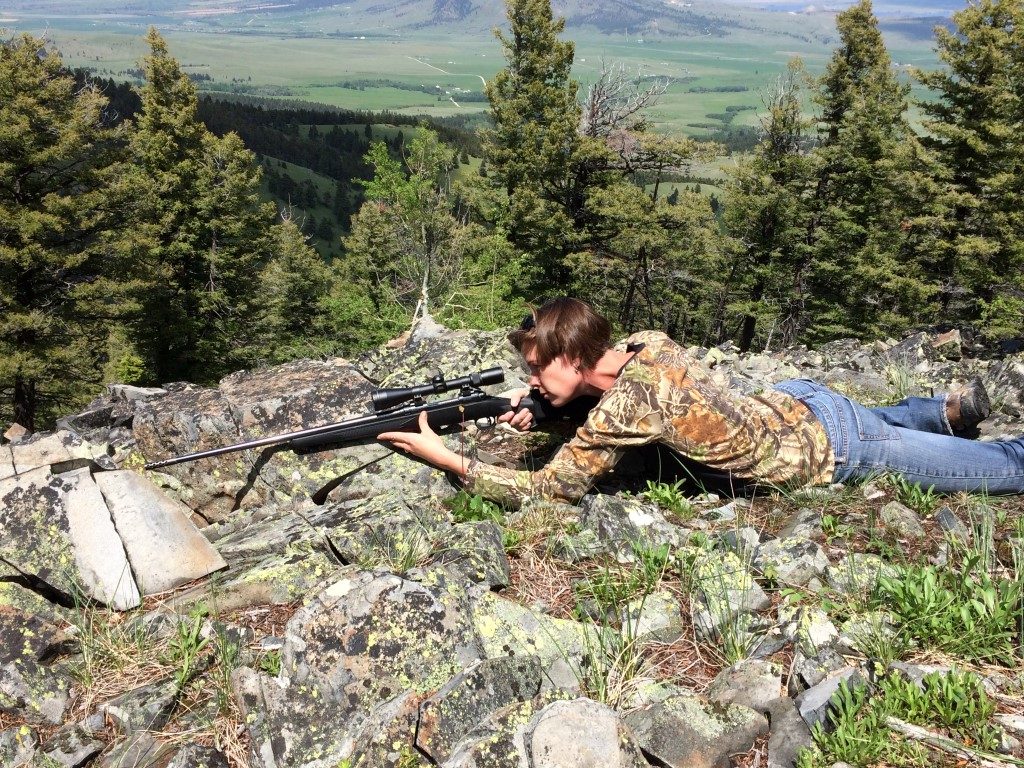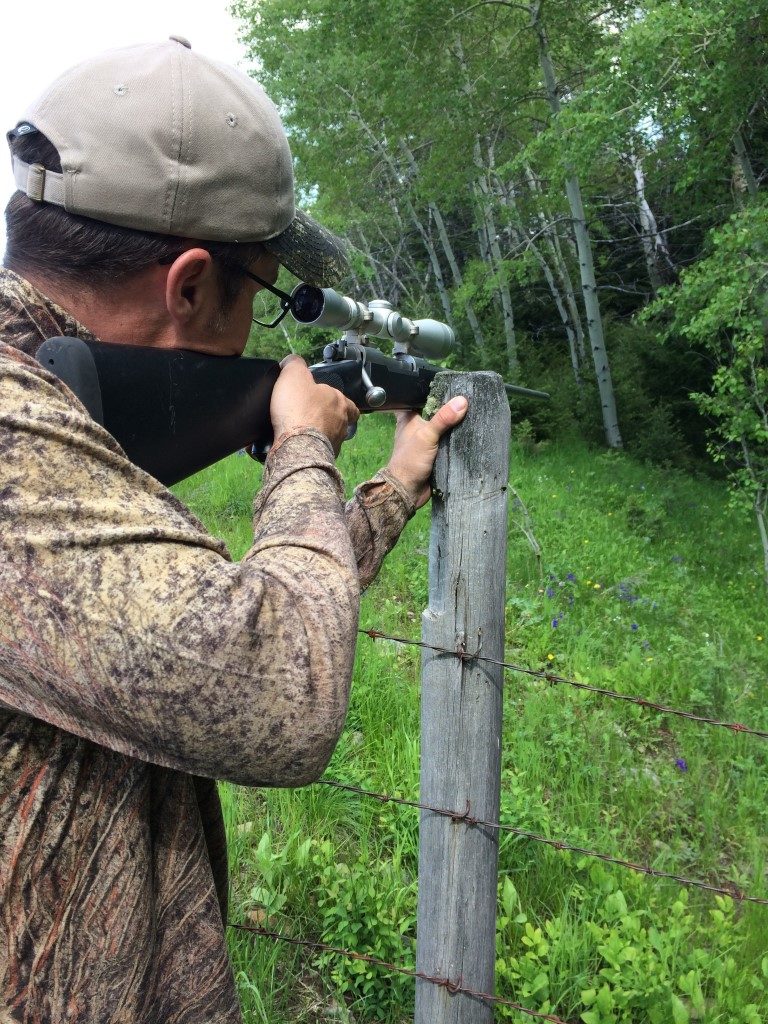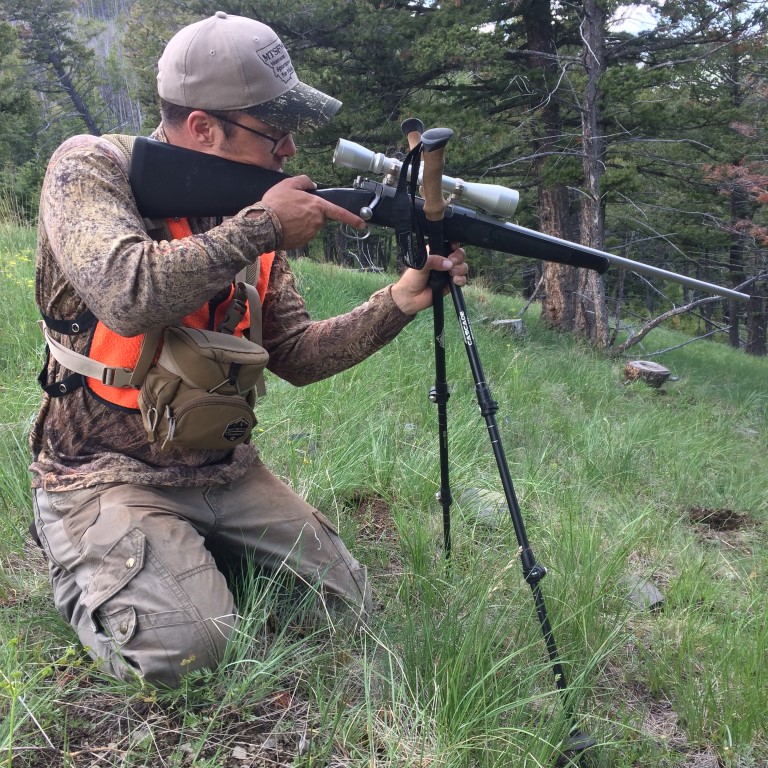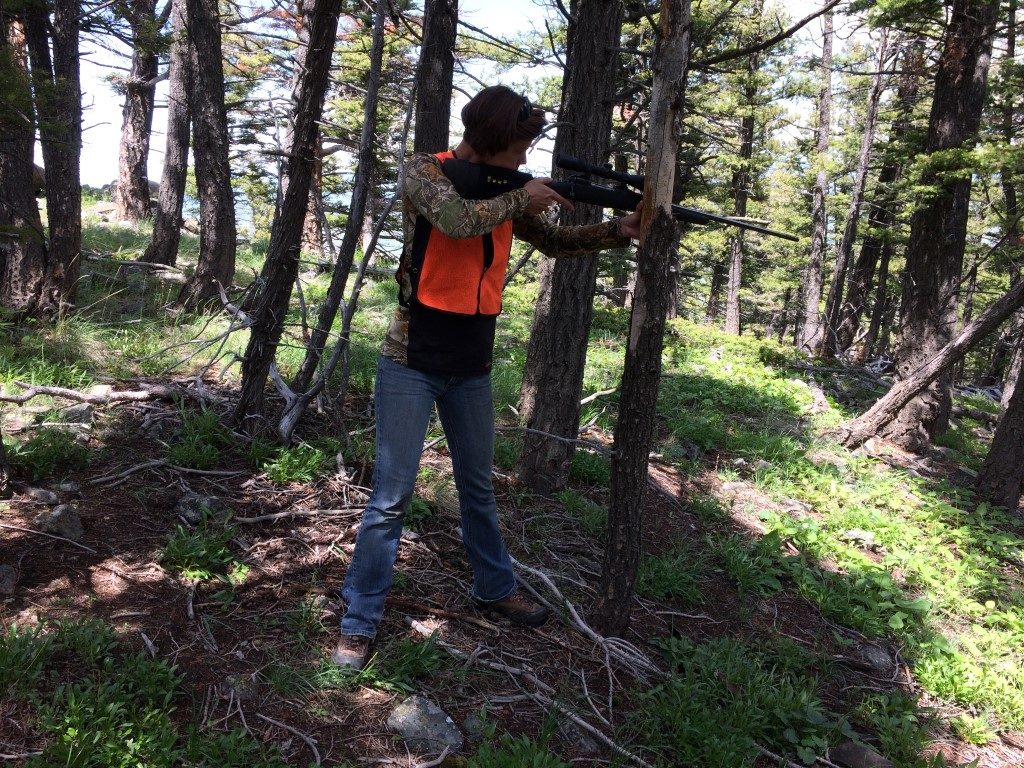I slipped through the lodgepole pines, carefully picking my footing. It was dead calm and cold; a great day to be hunting but a day when any sound made would travel a mile. Up ahead, the trees were starting to thin out, surrendering their grip on the south-facing mountainside. As I picked the remaining timber apart with my binocular an elk’s front leg came into view. I slowly worked closer to reveal a small herd gorging themselves on patches of feed poking through the snow, filling their bellies to fight off the brutally cold fall night that was well on its way. On the edge of the thickest timber a bull fed while several cows milled around below him. It wouldn’t take much disruption of this serene evening and he would take three steps and disappear into the timber and out of my life. I crept painstakingly towards a small opening that would hopefully offer an unfettered view of the bull. As I worked closer, an unseen branch broke under my boot, betraying my stalk. As one, the herds’ heads lifted, looking for the cause of the noise. The dun-colored bull breathed out, the steam jetting from his nostrils. I had wanted to make the edge of the cover for a prone shot but it was now or never. I slowly brought my rifle up against the side of a lodgepole pine, holding the trunk with several fingers, I flicked the safety forward.
Anyone who has spent much time afield has at least one similar occurrence as this, where quick thinking and adapting to an ever-changing situation either led to a downed animal or just a story of the one that got away. Being able to adapt on the fly to different shooting situations is a useful tool in any hunter’s toolbelt. In the heat of the moment, if we’ve prepared correctly, muscle memory should take over and help get us to the outcome we’ve worked so hard for. We prepare our gear, our vehicles, and our households for the days we spend in the field, why not prepare our bodies and minds as well?
Webster’s Dictionary defines muscle memory as: the ability to repeat a specific muscular movement with improved efficiency and accuracy that is acquired through practice and repetition. As hunters, we should take this information seriously and respond accordingly, heck, the word “accuracy” is even in the definition. With proper practice during the offseason, we can train our muscles to react without thinking in high-stress situations. For instance, that buck that you’ve patterned for a month before the season is now offering you a 5-second window to put your tag on him. Let’s say you’re walking to your treestand that you have hung anticipating this deer’s movement from weeks of careful research and scouting. You have a rail on your stand that will offer a steady rest for your rifle and shooting lanes cut. All you need is for the big one to walk by on the trail you’ve seen him use several times before. As you’re carefully slipping into your handpicked ambush site, crossing through a small opening in the river bottom brush you see the buck get up ahead and start to slowly fishhook around you. Now wouldn’t be the time to try a hurried, offhand shot. One mistake and he will be long gone. If you’ve done your preseason practice well, your mind will already be subconsciously gauging the situation for options, the height of the cover the animal’s moving through, shooting lanes available and the correct rest to make the shot.

When this pronghorn came in from an unexpected direction, quick-thinking and adaptability helped the author’s father anchor this mature buck.
While bipods and shooting sticks certainly have their place in the field, sometimes it’s just not feasible to have them on hand, for instance, a rifle packed in a scabbard on a horse or a backcountry sheep hunt where every ounce counts. With a little creativity and practice, our hunting gear and/or Mother Nature can provide the same stability at a moment’s notice as the most versatile bipod sold. For conciseness, I have left out unaided shooting positions; they are an article unto themselves. Here are some commonly found items that a hunter should have available to them to gain the upper hand this fall.
Fencelines- Using a post or wire from a fence is a solid option for most of us at one point or another. It is a universal, ready-made rest, easily adaptable to a prone, sitting, kneeling or standing hunter.
Vegetation- Unless you’re hunting antelope on Montana or Wyoming’s wide open prairies, there is usually an option for the enterprising hunter. A sagebrush may be used in a pinch for a prone shot or a tree trunk used as a permanent, overgrown shooting stick.
Daypacks- With the right terrain this multi-purpose tool is deadly in short grasses or laid on top of a ridge or other slight elevation change to give you a rock- solid prone rest for your rifle.
Trekking Poles- Not widely seen in the hunting world until several years ago, they are exploding in popularity. These can be one of the best investments a hunter makes. They save your knees and legs on days when you are making significant elevation changes and can be crossed for shooting sticks from a sitting or kneeling position.
We all prefer a calm, controlled environment when the moment of truth arrives but inevitably there will come a day when the circumstances don’t warrant setting up a bipod or shooting sticks. It is up to us to have achieved a level of comfortability with our field positions and shooting setup to make an ethical shot with what is available to us. Whether that is a daypack laid down for a prone shot at a whitetail across a food plot, or a lodgepole pine for support in blown down timber on an elk hunt, we bear the responsibility of the outcome. The best way to familiarize ourselves and be successful is to step away from the benchrest and get out in the field.
One of my favorite ways to get the trigger time essential to becoming a better shot is to take a rimfire rifle, a pocketful of shells, and my imagination for a walk in the hills. I started this as a boy, tried to continue the practice through my teenage years, and now take my sons to do the same. Stumps become bears, tree knots are trophy deer and so on. Practicing shooting at various targets from different positions and angles pays dividends when the moment of truth arrives. Hunters can experiment with different rests and see what works for their style and preferences. As the old saying goes “familiarity breeds success” and at the end of the day, that is what we are all striving for. On that bitterly cold evening elk hunt I just so happened to find it.
As the bull jerked his head up, realizing something wasn’t quite right, I pressed the trigger of my rifle. The solid whump of the bullet hitting was unmistakable and as he turned for the security of the timber I added a second shot to his vitals. Several minutes later while I collected my headlamp and knives from my pack, with the sweet musky odor of elk in my nostrils, I couldn’t help but think back on all of the tree knots and squirrels I had used that same shot setup on and smile.

When preparation meets opportunity. A makeshift rest helped ensure an ethical shot on this mule deer buck as he slipped through the open timber.
As hunters, it is our job when we are in the field to know our limitations as well as our strengths. The only way to achieve this is to practice and become familiar with our shooting setup and skills. If a hunter wants to add breadth to their repertoire, grab some trekking poles and a pack, hunker down on a fenceline and practice shooting off of each from a variety of positions. Have fun, be safe, and use your imagination.





Great advice and great stories to back it up. I couldnt help but think back to when I was a child and plinking soda pop cans in my back yard from various fighting/shooting positions…Thanks to the auther for triggering a trip down memory lane.